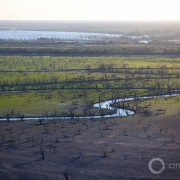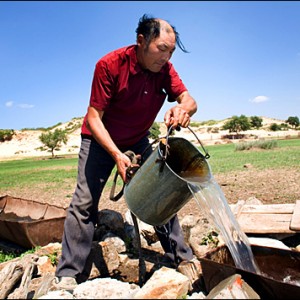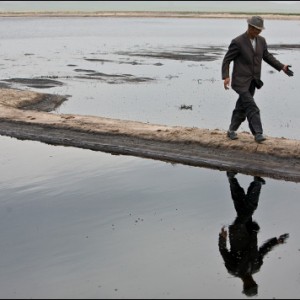A Track to Modern Nomads
Most of Circle of Blue’s reporting occurred in East Umchjin County, near the border with Mongolia, a place renowned for what Chinese scientists call “typical grasslands.” Here Eric Daigh, senior producer, prepares for an interview in a herder’s home. Photography by Palani Mohan, Getty Images, for Circle of Blue
By W. Chad Futrell
Special to Circle of Blue
The interviews and events described in this report occurred during a five-day trip in August 2007 from Beijing through the eastern region of Inner Mongolia. The trip leader, Chen Jiqun, a prominent Han Chinese artist, had distinguished himself as a noted environmental activist and grassland expert. Palani Mohan, an experienced photojournalist from Australia who has spent considerable time in China, and Eric Daigh, an American multi-media producer from Circle of Blue, joined us.
Our start in Beijing came amid a landscape that bears the marks of history and the severe water shortages that characterize all of northern China. Old canals, empty of water, run between rock formations that are, in some ways, reminiscent of the American southwest. Mountains of burnt-orange clay are ringed by withered trees in neat rows, testament to countless ineffective planting campaigns to hold back the desert.
Northern China is drying out, and there is little to suggest that the situation will change for the better. Roughly 500 million Chinese lack access to safe drinking water and modern sanitation, according to a World Bank study published earlier this year, most of them in northern China. Even the extraordinarily ambitious South-to-North water transfer project, a $62 billion plumbing job aimed at diverting 12 trillion gallons of water annually from the Yangtze River, and transporting it in three canals hundreds of miles north to the Yellow River, will not slake the region’s thirst. Northern China relies on wells drilled to tap groundwater, and aquifers are steadily dropping as northern China’s population and industrialization grows.
You can see that on the freeway from Beijing to Inner Mongolia, which is packed with big trucks. They follow the Yellow River westward towards central Inner Mongolia and Shanxi Province, the heart of China’s coal country. The economies and cities of northern Shanxi and central Inner Mongolia are growing rapidly as factories and mines compete for money earmarked for the Western Development Campaign, the central government’s big push to relieve population pressure along the coast by industrializing the west.
The idea is to reduce income inequality, and power the fastest growing industrial economy in the world. But the quickening and turbulent wave of economic development that has raised the quality of life for 400 million Chinese has also generated resource scarcity, enormous pollution, and waste not only for China but for the rest of the world. Almost 70 percent of China’s growing demand for electricity is fueled by coal. The country this year rushed past the United States as the largest emitter of carbon dioxide, a culprit in global warming. Global climate change is a factor, say climatologists, in northern China’s steadily increasing desertification. The wheel of prosperity that is lifting millions of Chinese out of abject poverty also is soiling the land and the water at a rate never before seen in history.
In East Umchjin County, A Competition For Resources
Most of our reporting occurred in East Umchjin County, near the border with Mongolia, a place renowned for what Chinese scientists call “typical grasslands.” Grass and sky stretched for miles and miles in every direction. In the distance mountains outlined the horizon. The wind, steady as a train, bore down from Mongolia and Siberia.
In 1949, 5.6 million people lived in Inner Mongolia, many of them nomadic herders, guiding flocks of sheep and herds of goats and cattle and horses from one traditional grazing area to the next. Today, according to the central government, 24 million people live in the enormous province, which covers an area nearly twice as large as France, and is China’s third largest. Most are non-native Han Chinese either pushed by the central government or attracted to the region by industrial and agricultural sector jobs.
Our trip reflected that demographic and industrial evolution. Two hundred miles from Beijing, as we entered Inner Mongolia, windmills were replaced by oil wells and coal mines, many of which have been built since 2000. We passed a dam and a reservoir that have enabled the city of Xilinhot, a city of 50,000 in 1990, to triple in size to 150,000 residents. Despite the reservoir the city, like so many others in northern China, faces a water shortage.
A World of Grass and Sky
A day’s drive from Xilinhot another world opened to us at Nomad Family, a cultural tourist site, where men and women in full traditional Mongol dress greeted us. Nomad Family village is five white yurts standing in a line, with a larger yurt in the back. A small windmill whirled, its wires tied to solar panels that met at the batteries that provide almost all of the yurts’ electricity. The fact that these people’s lives are extraordinarily energy-efficient was further reinforced by the pile of dry cow dung, used as fuel, that lay alongside the kitchen yurt.
Indeed, it is rare to see a Mongol herder house or yurt without a small windmill and solar panels. Given how little it rains and the near constant wind, living off the grid is a common way of life. In most of the province, there is no grid.
The serious water shortages that are swiftly converting much of Inner Mongolia to desert were apparent at a personal level at Nomad Family. Water for drinking, bathing, and washing is collected from a well a mile away using a wagon and a stubborn cow pulling a large water container. The men at Nomad Family made the trip on horseback. Women walked.
But there was also a genuinely elegant rhythm to life at Nomad Family. At night we were invited to a meal of beef and lamb, homemade cheese, yogurt, butter, and milk tea. Inner Mongolians eat only what they make themselves. Afterwards we stepped into the wind outside, to a darkened sky and a breathtaking canopy of stars.
W. Chad Futrell is a Ph.D. candidate in development sociology at Cornell University. He recently completed two years of fieldwork on transnational environmental cooperation to prevent desertification and protect wetlands in Northeast Asia, funded by Fulbright-Hays and Korea Foundation fieldwork fellowships. Reach him at wchadfutrell@gmail.com.
Research and editing assistance for this article was provided by Jennifer L. Turner, the director of the China Environment Forum at the Woodrow Wilson Center in Washington, DC. Reach her at cef@wilsoncenter.org.











Leave a Reply
Want to join the discussion?Feel free to contribute!